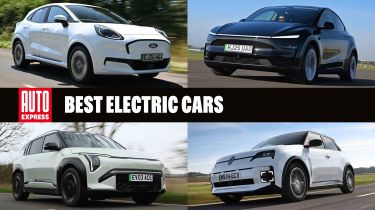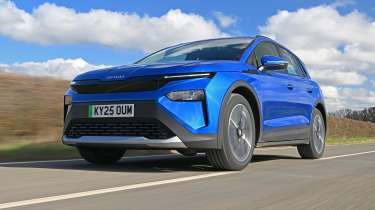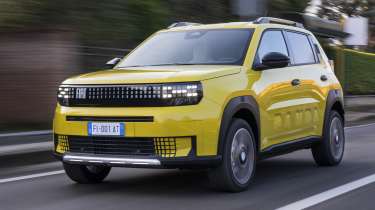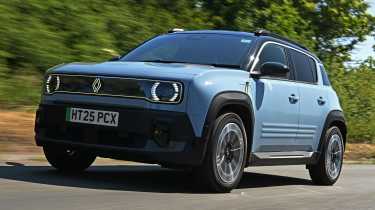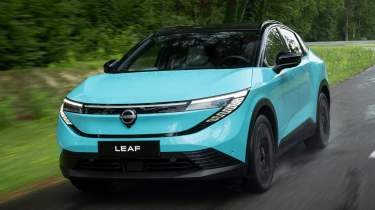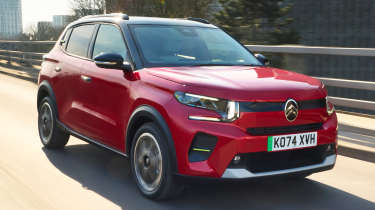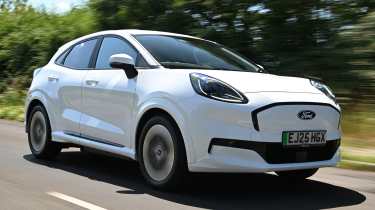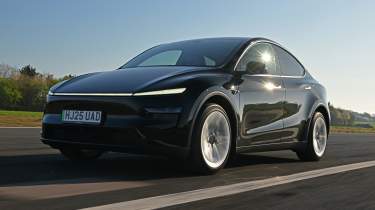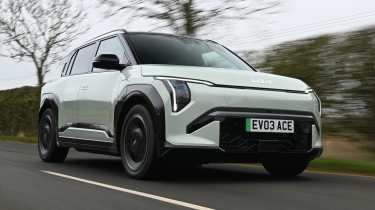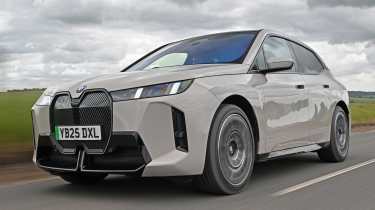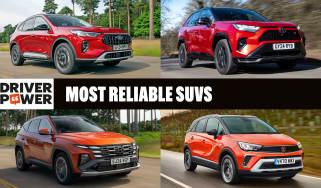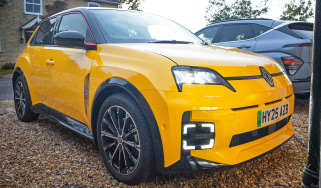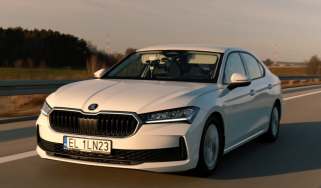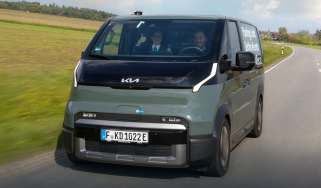Best electric cars 2025/2026
Thinking about making the switch to an electric car? Here are the best EVs that should be on your shortlist, and why…
So you’re thinking about buying an electric car? You’re not alone and you’ve come to the right place.
Our expert road testers have driven every electric car available in the UK, comparing them all over hundreds of miles, in all kinds of driving conditions, to find out which models truly stand out from the ever-growing pack.
Being ranked as one of our best electric cars has never been tougher. We look at everything from battery range and charging speeds, to price, practicality, driving experience, technology, design and overall value for money – ensuring you get a complete picture before making any buying decisions.
Our list of best electric cars is constantly updated too, as new EVs are launched on to the market and existing models are refreshed to keep up. You’ll always get the latest and best expert EV buying advice on this page…
If you have a more specific electric car in mind then check out these guides:
- Longest range electric cars
- Best luxury electric cars
- Best electric SUVs
- Best 7-seater electric cars
- Best small electric cars
- Cheapest electric cars
- Fastest electric cars
Not sure if electric cars are right for you? Take a look at the best hybrid cars available.
1. Skoda Elroq
- Prices from £32,000
- Auto Express Car of the Year 2025
- Best electric car overall
Pros |
|
Cons |
|
Skoda doesn’t tend to miss the mark when it launches new cars, and the Skoda Elroq, a small electric SUV, is no different. In fact, the marque has done such a good job with the Elroq, that we named the car as our Car of the Year at the 2025 New Car Awards, where it beat the likes of the Renault 4, Renault 5 and Fiat Grande Panda to the crown.
Skoda has taken a slightly different approach to the Elroq’s styling and it’ll take a little while before the new grille-less front end starts looking like a Skoda to us. But a sophisticated cabin, quick charging speeds (up to 175kW), and competitive pricing (starting from under £32,000) make the Elroq one of our favourite EVs and the top choice for young families.
It’s a sign of how well Skoda understands its buyers that the Elroq drives almost exactly as you’d hope a family car would. It feels substantial but not unwieldy, has a mature ride quality but doesn’t loll around in corners, and it’s very easy to meter out as much or little power as you need at any speed. Even on the maximum setting, the regenerative braking system doesn’t quite offer one-pedal driving, so you’ll need to use the brakes, but it’s a very easy set-up to manage.
The Elroq’s interior is smart and modern. A few too many controls are buried within the touchscreen – a Renault Megane or Scenic is a little easier to interact with on the move – but the screen is otherwise very intuitive. There’s loads of room front and rear too, with large thigh cushions for the rear seat passengers to account for the higher floor, and a decent 470-litre boot.
“The Elroq is so good that we see it creating a bit of a dilemma for Skoda: why would anybody need the larger Enyaq now?” – Ellis Hyde, news reporter.
2. Renault 5
- Prices from £21,500
- Best for retro style
Pros |
|
Cons |
|
The Renault 5 is a brilliant fusion of retro design and everyday practicality. It takes design cues from the classic seventies original, but is also a thoroughly modern design, packed with neat touches yet also very fairly priced, starting from around £21,500 when you take the Electric Car Grant into account.
With a 148bhp motor and the option of a 40kWh or 52kWh battery, it claims to provide up to 252 miles of range and can sprint from 0-62mph in just eight seconds. It’s one of the most desirable small cars in years, and brings a winning combination of style, technology, and enjoyment to its segment.
The Renault 5 is a pleasure to drive, offering a smooth, comfortable ride that feels right at home on city streets. The handling is responsive and agile, with just enough sportiness to keep things fun through corners. The suspension works hard to smooth out rough roads, providing a ride that’s both comfortable and confident. Real-world efficiency suffers a little at speed, but you should be able to get 200 miles on a charge in the larger-battery version.
When we drove the car in a mix of environments (including on the motorway), we achieved 4.1 miles per kilowatt-hour, rising to 5.0mi/kWh around town. This means you could see well over the claimed WLTP combined range.
Space is another plus point for the Renault 5, with its 326-litre boot trumping many competitors, including the MINI Cooper E. Rear doors make everyday life even more convenient, while the seats are inspired by those from the classic Renault 5 Turbo and offer excellent comfort on long journeys.
Inside, the R5 strikes a fine balance between nostalgia and modern tech. The Google-based infotainment system is intuitive, updatable and loaded with useful features.
“The Renault 5 plays heavily on nostalgia and there’s so much joy in this little package that it’s impossible not to be impressed” – Jordan Katsianis, senior staff writer.
3. Fiat Grande Panda
- Prices from £21,000
- Auto Express Supermini of the Year 2025
Pros |
|
Cons |
|
The new Fiat Grande Panda is a bigger and more sophisticated car than its predecessor, but it retains the same core qualities: simple, durable and affordable.
Starting from just over £21,000, it's one of the cheapest electric cars currently on sale in the UK. And it only comes with one battery choice, a 44kWh pack which officially provides up to 199 miles of range on the WLTP combined cycle.
Our testing has shown the Fiat to be very efficient at slow speeds and around town. The 199-mile figure dropped considerably once we ventured onto faster roads, with the squared-off front end hampering aerodynamics. We saw a real-world range of around 145 miles on a route that was evenly split between city, country roads and high-speed motorways. This should be plenty for most commutes and short journeys.
On the road, the Fiat Grande Panda is calm and composed, and its slim shape makes it feel right at home on narrow city streets. The handling is tight and it's quick to respond when you turn the wheel, but it doesn’t quite have the same sporty edge as the Renault 5.
Where the Grande Panda performs slightly better than the Renault is over rough road surfaces. When driving through central Turin in Italy, the Grande Panda’s suspension made light work of cobbles, potholes and speed humps. It felt very polished and quite plush for a car of its size. Overall visibility is very good and with its stubby dimensions you shouldn’t find it too difficult to park in narrow spaces.
The Grande Panda is also reasonably practical for a car in this class. There are plenty of storage cubbies dotted around the cabin, and the boot is a decent size at 412 litres. This is much larger than in rivals such as the Citroen e-C3, which only has 310 litres of boot space, or the Renault 5 with its 326-litre capacity.
If you carry passengers more than you do bulky cargo, the Fiat might feel a little cramped for taller occupants, especially in the rear. The floor is quite high and there’s a hump that can eat into foot space.
“On the road, even in somewhat dreary weather, the exterior looks fresh and vibrant. Its sleek face hides the headlights, daytime running lights and even a clever retractable charging cable. This is just the start of a whole host of clever detailing that’s evident almost everywhere you care to look.” - Jordan Katsianis, senior staff writer.
Latest Fiat Grande Panda deals
4. Renault 4
- Prices from £25,500
- Auto Express Small SUV of the Year 2025
Pros |
|
Cons |
|
Renault is clearly on a roll at the moment, and if you thought the Renault 5 was the best retro-inspired car the manufacturer could create, the Renault 4 asks you to think again.
Starting from around £25,500, the Renault 4 is one of the best-value small SUVs currently on sale. There’s just one powertrain – the same 148bhp motor and 52kWh battery that you’ll find in the Renault 5 supermini.
While the battery might be the same as in the R5, the extra space offered by the R4’s small SUV-style body doesn’t have a negative impact on efficiency. The maximum claimed WLTP range is 247 miles, which is just five miles less than the smaller Renault 5. When we drove the Renault 4 over a mixture of roads, we saw an average of 3.8mi/kWh and a real-world range of just shy of 200 miles. We reckon a more considered driving style would see you get much closer to the claimed range.
On the road, the Renault 4 is smooth and comfortable, with Renault opting for a slightly softer set-up for the R4 than its R5 sibling. This doesn’t mean the R4 isn’t fun to drive; on the contrary, there's a willingness to change direction that’s missing in plenty of its rivals. The suspension does a good job of smoothing out rough roads, especially at higher speeds. Things can feel a little harsh at slower speeds, however.
Space is another plus point for the Renault 4. It has a 420-litre boot, which is much larger than rivals like the Fiat 600e, which has 360 litres of space, but the R4 can’t quite match the 556 litres in the Ford Puma Gen-E. The rear door openings are nice and wide, and the boxier shape helps give a little more head and legroom for passengers than they get in the Puma Gen-E.
Renault hit on a winning formula when it came to the interior of the R5 and sensibly reused it in the R4. Inside, the 4 strikes a balance of being modern and tech-filled while retaining a touch of retro nostalgia. The Google-based infotainment system is intuitive, and comes with loads of useful features. It’s one of the best infotainment systems you can currently find in any car.
“The Renault 4 draws inspiration from the company’s back catalogue, but the E-Tech model is light years ahead in terms of quality. While the dashboard layout is identical to the R5’s, the separate climate controls and stubby infotainment control stalk on the steering column will also be familiar to anyone who’s driven a modern Renault.” – Alex Ingram, chief reviewer.
5. Nissan Leaf
Pros |
|
Cons |
|
It’s safe to say that Nissan has reinvented the Leaf for the latest generation, with the Japanese giant doing a fantastic job of turning the electric hatchback into a stylish crossover, which is comfortable, refined and approachable.
The Nissan Leaf comes with two battery options: either a 52kWh battery with a WLTP range figure of around 270 miles, or a much larger 75kWh pack that brings the range up to 375 miles. While we are yet to drive the car for a sustained period on public roads, our early impressions were very positive; the car’s efficiency was comparable with that of key rivals such as the Volkswagen ID.3 or Kia EV3. Charging speeds are slightly on the slower side at up to 150kW, but you’ll still be able to charge from 20 to 80 per cent in under 30 minutes.
On the road, the Leaf is calm and confidence-inspiring to drive, which is in tune with the Nissan’s target market. The suspension and ride quality are very impressive, taking large undulating potholes in their stride without feeling unsettled or jittery. When driving the car in Germany, we found the body remained free of creaks or rattles, even when driving over really rough cobbles.
Space is another plus point for the Nissan Leaf. Its 437-litre boot is larger than in rivals such as the Volkswagen ID.3, which has 385 litres, but can’t quite match the 460 litres in the Kia EV3. Both of these cars have boxier silhouettes and don’t have the same sloping roofline as the Leaf – this eats into the space when loading bulky items, as well as rear passenger headroom.
Nissan has found a good balance between the use of physical switches and touch-sensitive controls, although the latter do take some time to get used to. The infotainment system is simple to use and thanks to it being underpinned by Google software, it is very approachable in its design.
“Rivals like the Volkswagen ID.3 feel a little bouncy and lack the polish and bump isolation that the Nissan Leaf offers. Overall refinement is also excellent. There are good levels of sound deadening from road roar and very little wind noise, with the exception of the wing mirrors’ tendency to whip up a bit of a racket.” - Jordan Katsianis, senior staff writer.
6. Citroen e-C3
- Prices from £20,100
Pros |
|
Cons |
|
One of the biggest hurdles for potential buyers making the switch to an electric car is price. So, rather than pumping its electric supermini full of unnecessary and costly bells and whistles, Citroen has made the Citroen e-C3 a sensible little car that comes with the kit that you’ll actually need, at a price that many can realistically afford.
There are cheaper electric cars, such as the Dacia Spring and Leapmotor T03, but they’re no match for the Citroen e-C3 when it comes to practicality, battery range or equipment. It’s an excellent package at a very reasonable price, and that’s why the Citroen e-C3 was named our 2024 Car of the Year.
With an official range of up to 199 miles per charge, the e-C3 is surprisingly capable at taking on family car duties. We averaged 3.5 miles per kWh on our test, which translates to a real-world range of 153 miles, but staying off the motorways saw this rise to an excellent 5.0mi/kWh – and a projected range of 220 miles. That’s very close to the figure we achieved in a Renault 5, which has a larger battery and less space inside.
Citroen has avoided the trend for sporty handling, instead making the e-C3 ride and steer in a relaxed way that’s unusual for a car so small; the approach is enhanced further by the squashy ‘Advanced Comfort’ seats. The trade-off is that you won’t enjoy corners that much, but the light steering makes town driving very easy indeed. Performance is modest for an EV, but more than a match for petrol superminis that cost similar amounts.
Despite the e-C3’s low price, its cabin doesn’t feel pared-back to the bone – there’s a bit of design flair in the horizontal dashboard layout with its fabric trim elements, and an impressive amount of cabin space for the car’s size, especially in the rear seats.
“The e-C3 is the first usable, small electric car that’s the same price as petrol-powered alternatives without presenting any obvious compromises” – Alex Ingram, chief reviewer.
7. Ford Puma Gen-E
- Prices from £26,245
Pros |
|
Cons |
|
The Ford Puma is currently one of the best-selling new cars in the UK, so it’s no real surprise that the electric version, the Puma Gen-E, happens to be one of the best electric cars, too.
There’s only one powertrain option – a 53kWh battery with a usable capacity of 43kWh, and a 166bhp electric motor – and while the pack might seem on the smaller side, the Puma Gen-E is very efficient. When testing the Ford against the Renault 4, the Puma’s average efficiency never dropped below 4.4mi/kWh, and increased to between 5-6 mi/kWh at urban speeds. This meant we saw a real-world range of 202 miles, which is similar to what you’ll get in less efficient rivals with bigger batteries.
The Ford Puma is one of the most entertaining small SUVs on the road and the Puma Gen-E follows the same formula. Overall performance is sprightly and the steering is responsive on a twisty road, which makes the car feel agile. The added weight of the battery pack does increase body roll slightly when the car is being pushed but is mostly kept in check. One positive result of this is that the Gen-E is a little more comfortable at slower speeds than the standard Puma.
The Gen-E also has lots of usable space inside. While rear-seat passengers might feel a little on the cramped side with tight knee and headroom, what you lose in cabin space is made up for by the vast boot. It looks pretty average at first, but lift up the floor and you’ll be greeted by the GigaBox, adding an extra 145 litres.
With a starting price of just over £26,000, the Puma Gen-E’s cabin feels well built and sturdy. We did note that while the use of gloss-black plastic on the centre console looks stylish, it will pick up scratches quite easily.
"It’s one thing testing electric cars in the summer months, but in winter, colder temperatures will take a chunk out of the Puma’s driving range. Ford mitigates against this by fitting the Gen-E with a heat pump as standard, which is surprising because it’s an option on the pricier Explorer and Capri" - Dean Gibson, senior test editor.
8. Tesla Model Y
- Prices from £45,000
- Best for range and charging
Pros |
|
Cons |
|
With its long range, mind-boggling performance and minimalist, hi-tech cabin, it’s not hard to understand why the Tesla Model Y has been such a hit since it went into production in 2020. In fact, you’ll struggle to not stumble across a dozen Model Ys wherever you go in Britain these days.
The car’s refresh in 2025 only added to its appeal with a range of up to 311 miles for the entry-level rear-drive model and a charging speed of up to 250kW, making it one of the fastest-charging cars in its class.
High performance has always been a Tesla hallmark and the Model Y delivers here too. Even the 279bhp base model is brisk with a 5.6-second 0-62mph time, while the Model Y Performance makes 460bhp and gets from 0-62mph in 3.3 seconds. It’s got a firm but controlled ride, but the new car is much more refined and comfortable than the previous version.
The centrepiece of the Model Y’s minimalist cabin is a large 15.4-inch touchscreen. Unlike its Model 3 sister car, the Model Y does have an indicator stalk, but it is flimsy and difficult when trying to cancel a turn signal.
Space is in abundance in the Model Y. Despite the curved roof, it’s a tall car, which makes it easy when transporting bulky items. The boot has a low floor and thanks to having 890 litres of space with the rear seats in place, it eclipses rivals including the Kia EV6 or Audi Q4 which only have 490 and 520 litres, respectively.
“When it comes to charging, few manufacturers can touch the convenience that Tesla can offer. Drive to your nearest Supercharger, park up and plug in. Once you have enough charge, you can leave, and your usage is charged by direct debit each month. We really wish all charging networks were this easy to use.” - Alex Ingram, chief reviewer.
9. Kia EV3
- Prices from £33,000
- Best for company car drivers
Pros |
|
Cons |
|
Kia really understands the assignment with electric cars. The Niro offers plenty of range at a good price, the EV6 looks great and really stepped up the brand’s performance game, the EV9 is hugely impressive (and hugely huge), and the new EV3 is like a scaled-down EV9, yet offers up to 372 miles of range despite its compact size. It’s more of the same from the Korean brand and we really like it.
The Kia EV3 doesn’t offer the slightly mad performance you’ll get from the similarly-sized Volvo EX30, but 0-62mph times in the seven-second range are plenty for a family hatch, and different driving modes let you tailor the electric motor’s response to your tastes.
What the modes don’t do is make the EV3 fun to drive, and the soft suspension can sometimes struggle with the Kia’s weight – but the rest of the time, most drivers will appreciate the fairly relaxed ride quality (on the motorway especially), impressive refinement, and several levels of braking regeneration, from coasting to one-pedal driving.
The boxy looks suggest huge cabin space but the Kia isn’t quite as commodious as you’d expect, partly thanks to a high floor that pushes rear passengers’ legs upwards and leaves them short of thigh support. Those in the front are unlikely to complain with the logical and uncluttered dash. The 460-litre boot is a pretty good size for the class, too.
“Kia’s new compact electric SUV offers a long range, a practical boot, and good passenger comfort in a stylish package” – Alex Ingram, chief reviewer.
10. BMW iX
- Prices from £75,500
- Best for luxury
Pros |
|
Cons |
|
The design of the BMW iX might be controversial, but it’s a seriously impressive car that’s comfortable, great to drive, has an impressive range and is packed with tech.
With 94kWh and 112kWh battery options you get range estimates of 374 miles and 424 miles respectively. On our most recent test of the iX we managed to achieve an average 3.5mi/kWh which is very respectable for a car of this size and a significant improvement on what we achieved in earlier models. Charging speeds are strong, too, ranging between 175 and 195kW.
No matter which iX you go for, it’ll have loads of power and the light and direct steering really helps hide the car's weight for the most part. The suspension is well balanced overall, but we did notice that over smaller bumps the iX felt fidgety and there was a tendency to thump into larger bumps. This was the only place where you felt the car’s 2.4-tonne kerbweight, though.
The BMW’s interior feels suitably luxurious, oozing quality and an ultra-modern feel, combined with lots of soft-touch materials. The infotainment system is one of the best currently on the market, because BMW kept the iDrive clickwheel input for this generation.
The iX is incredibly practical, too, with very few rivals offering more space. Head and knee room for rear-seat passengers is generous, plus the large rear windows and panoramic sunroof make it feel light and airy. The boot measures in at 500 litres, although if you do need more space, then the Mercedes EQE SUV offers 45 litres extra. It’s worth noting that the iX’s rear seats fold almost flat though.
“The iX’s party piece is how it can combine this performance and refinement without feeling all at sea through the corners. Yes, that weight is ever-present, but it feels no more chunky than a decent-sized executive saloon would in most situations.” - Alex Ingram, chief reviewer.
How we choose the best electric cars
Here at Auto Express our extensive testing programme examines every new car on sale in detail, so it’s only natural that an ever-increasing proportion of those cars are EVs.
Just as with petrol, diesel, hybrid and plug-in hybrid cars, we test every aspect of the electric vehicle’s make-up. But with pure-electric models we pay particular attention to the following areas – and so should you when taking your test drive:
- Long real-world driving range in warm and cold weather
- Fast charging speeds
- Good regenerative braking system with natural responses
- Infotainment includes features that find and manage charging
- Good charging cable storage
Beyond that, we test the same things we look for on any car, from the driving experience to the infotainment system and the practicality of the interior. All are carefully evaluated by our experts to determine exactly where the car sits in relation to similar models that you might be considering.
We also know that price is a huge factor for EV buyers, with 52 per cent of our readers telling us that finding the best deal is the most important part of the car-buying process for them, so our experts also analyse the market to carefully compare the prices, plus the leasing and finance deals, of each model. All-in-all, our extensive testing process is designed to bring you the definitive verdict on the best electric cars to buy.
Frequently Asked Questions
Electric cars have zero exhaust or tailpipe emissions so they don’t produce the localised NOx and particulate emissions that have a damaging effect on air quality in urban areas. However, the overall environmental credentials of an electric car depend greatly on the source of the electricity used to charge it. As the energy mix of the National Grid moves towards renewable sources like solar, wind and tidal power and away from fossil fuels, electric cars get greener. Green NCAP has published whole life emissions estimates for various cars with small electric vehicles performing better than any ICE cars.
There's more information to help you make your electric car choices in our full guide on if you should buy an electric car
